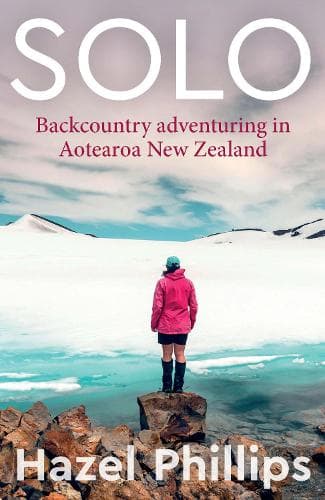Review: Solo: Backcountry adventuring in Aotearoa New Zealand
Reviewed by Alex Eagles
In 2017, after packing her life into a tramping pack and swapping high heels for boots and gaiters, Hazel Phillips decided to become “intentionally homeless.” For three years she lived almost entirely in tramping huts and alpine club lodges around Aotearoa while holding down a full-time job in communications.
Solo: Backcountry adventuring in Aotearoa New Zealand is the resulting autobiographical account of the author’s physical and emotional journey as she traversed backcountry trails from Ruapehu to Fiordland in search of herself.
While Solo has been released just in time for the 20th New Zealand Mountain Film and Book Festival (24 June - 2 July), it not a book just for serious hikers. For those new to tramping or contemplating more adventurous treks, Phillips talks about how she gradually increased her fitness and skill level from overweight and inexperienced to a fit veteran doing treks lasting weeks through rugged (often icy) terrain.
The book also includes a pack full of practical information as the author shares tips, track and hut reviews, useful gear - including extra underwear, safety issues - especially being prepared for changing weather and how to deal with people who put you down by proving them wrong.
While I have never been as adventurous as the author, I have done my share of multi-day and altitude tramping. Phillip’s definition of “type two fun” - experiences that are “not fun at the time” but later make up some of your best and most enduring trekking memories - brought back my own fond tramping recollections including being nearly swept away in a river, wading through a swamp up to my thighs and having a mouse fall on my face in an alpine hut.
Much to my surprise, however, it was the author’s personal journey that I found most intriguing as she strove to overcome her fears, deal with heartache and find a place to belong. While the book is mainly about tramping, snippets of Phillip’s private life are finely woven through the pages.
The list of Phillip’s credentials makes fascinating reading themselves. After a degree in foreign languages, Phillips did a post-graduate diploma in teaching. However, deciding that teaching was not for her, she then undertook an MA in Media Studies. Phillips worked for numerous organisations, including New Idea as associate editor, sub-editor for Australian NW and CLEO as well as freelancing for publications like Lucky Break.
Phillip’s own lucky break came when she took over the long-standing column ‘Ad Hoc’ with the prestigious National Business Review. This led to a short stint in the glamorous world of television in 2010 as the host of The Ad Show. In 2011 she became the editor of Idealog, a magazine reporting on business innovations. Phillip’s released her first book, Sell, in 2013, about New Zealand advertising, and another in 2014 on Sir Bob Harvey. She has also been a regular contributor to tramping magazines including Wilderness. Now, she’s completing an MA in Creative Writing.
Obviously an experienced author, Phillip’s writing style is highly readable and dotted with humour. However, from someone who once commented that she wanted to, “save the adverb from a grisly death,” more descriptive writing would have been welcomed to experience the breath-taking views through her words. The fact that most images in the book are sans colour made this especially pertinent.
Colour photos in printed material cost a lot, so these are limited to a select few in the middle of the book. Black and white images of spectacular views are abundant throughout; still, I found myself longing to see the hues of the sky, rocks, rivers and peaks.
Numerous interesting historical facts appear throughout the book, many of which add to the story. However, other pieces seem slightly discordant. A friend of Hazel’s commented that she had become obsessed with reports of people who perished in the New Zealand wilderness and I have to concur. If you like reading about this sort of thing, there are numerous such accounts; if you don’t, it is easy to skim read over these bits to get to the more positive parts.
Reviewed by Alex Eagles
